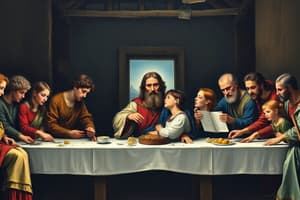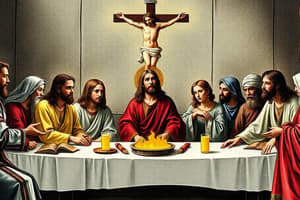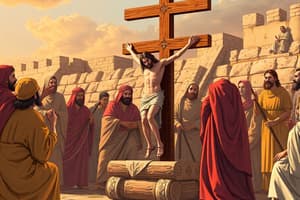Podcast
Questions and Answers
What major event does the Passover Meal commemorate?
What major event does the Passover Meal commemorate?
- The celebration of the resurrection
- The birth of Jesus Christ
- The covenant between God and the Israelites (correct)
- The ascension of Jesus
Which part of the Eucharist involves listening to God's word?
Which part of the Eucharist involves listening to God's word?
- Memorial of the Last Supper
- Liturgy of the Word (correct)
- Liturgy of the Eucharist
- Sharing of the bread
Which of the following is not one of the common values mentioned?
Which of the following is not one of the common values mentioned?
- Respect
- Generosity (correct)
- Honesty
- Fairness
Who was responsible for translating the Bible into Latin?
Who was responsible for translating the Bible into Latin?
What does transubstantiation refer to in the context of the Eucharist?
What does transubstantiation refer to in the context of the Eucharist?
Which term refers to the quality of being honest and having strong moral principles?
Which term refers to the quality of being honest and having strong moral principles?
What was the first canon of the Bible produced by the Council of Caodicea?
What was the first canon of the Bible produced by the Council of Caodicea?
Which of the following is a step in being accountable?
Which of the following is a step in being accountable?
Flashcards are hidden until you start studying
Study Notes
Passover Meal and Eucharist
- The Last Supper Jesus shared with His disciples was rooted in the Passover meal from the Old Testament.
- Jesus instituted the Eucharist as a memorial celebration of the new covenant.
- Holy Thursday commemorates this institution in the Church's liturgy.
Characteristics of the Passover Meal
- The Passover meal was traditionally a joyful family gathering centered around the Father.
- It served as a celebration of gratitude and remembrance.
Eucharistic Elements
- Jesus utilized wine, offering a blessing in thanksgiving.
- He similarly blessed bread during the meal.
- The Eucharist comprises two main parts: the Liturgy of the Word and the Liturgy of the Eucharist.
Eucharistic Celebration Structure
- The Eucharistic celebration begins with the priest's greeting.
- A penitential rite follows, allowing for reflection and admission of sins.
- A hymn of praise may be sung, especially on Sundays and feast days.
- The opening prayer concludes the introductory rite.
Ethical Considerations and Values
- Ethics involves meal principles and guidelines for behavior.
- Integrity signifies honesty and adherence to strong moral principles.
- Accountability ensures individuals or organizations are held responsible for their actions.
- Diligence highlights the importance of careful and persistent effort.
- Perseverance relates to maintaining consistent effort over time.
- Common values include fairness, respect, care, and honesty.
Steps of Accountability
- Know your role for clarity in responsibilities.
- Be honest in all interactions.
- Apologize when necessary to maintain relationships.
- Use time wisely to increase productivity.
- Avoid overcommitting to ensure quality and reliability.
- Reflect on actions to inform future behavior.
Discipline and Behavior Standards
- Discipline involves training individuals to follow rules and codes of conduct.
- Values are personal beliefs that influence actions and decision-making.
Liturgy of the Word
- During this segment of the celebration, attendees listen to the Word of God.
Transubstantiation
- In the process of transubstantiation, the bread and wine are believed to be transformed into the body and blood of Christ.
Formation of the Bible
- The Catholic Church played a crucial role in compiling the Bible.
- Melito, Bishop of Sardis, contributed to early biblical understanding around 170 AD.
- The Council of Laodicea (360 AD) established the first canon of Scripture.
- Pope Damasus I, in 367 AD, commissioned St. Jerome to translate biblical texts into Latin, leading to the "Latin Vulgate."
- St. Jerome dedicated 30 years in a cave for this translation, completing it in 397 AD.
Biblical Terminology and Structure
- Pope Siricius labeled the collected texts as the Bible, and the term "New Testament" was introduced around 200 AD.
- Archbishop Stephen Langton and Cardinal Hugo de Caro are credited with creating the chapter and verse structure in the Bible.
Name Significance
- Joshua (Yehoshua) is the Hebrew name for Jesus, translating to "God saves."
Studying That Suits You
Use AI to generate personalized quizzes and flashcards to suit your learning preferences.




